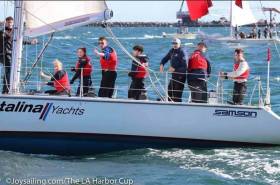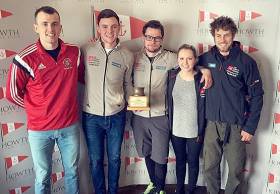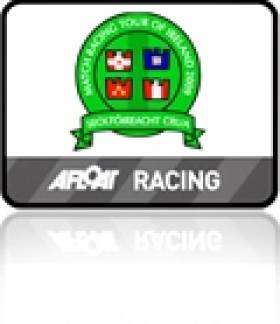Displaying items by tag: CIT
CIT Third at Port of Los Angeles Harbour Cup
A Cork Institute of Technology sailing team has finished third overall at the Port of Los Angeles Harbour Cup event held this weekend.
As Afloat.ie reported previously, Led by 29er dinghy ace Harry Durcan of Crosshaven on the helm and captain Grattan Roberts, the sole Irish team competed in the Los Angeles Yacht Club (LAYC) and Cal Maritime Sailing hosted event.
The regatta used the identically matched fleet of Catalina 37s provided by the Long Beach sailing Foundational, these boats are used in the prestigious Congressional Cup.
They raced against the top five west and top four east coasts American Universities that include the Naval and Coast guard academies over the course of a competitive 3-day event. The College of Charleston won overall on 25 points, California Maritime Academy was second on 32 and the Cork Harbour team third on 39 points. See overall results here

CIT Finish Fourth At Student Yachting World Cup, France
Cork Institute of Technology have finished fourth overall at the Student Yachting World Cup in France. It is disappointing result for Team Ireland after being in the top three overall all week.
Yesterday was very shifty on the water with breeze flicking from left to right for the two races, making conditions challenging for the crew.
There was consolation for CIT though who come away with a trophy for winning the night race.
CIT Win Student Yachting Nationals & Represent Ireland at SYWoC
CIT won the IUSA Student Yachting National Championships at Howth Yacht Club, Dublin last Friday by a single point and qualified to represent Ireland at the Student Yachting World Championships in La Rochelle, France in November 2016.
This is the first time CIT have claimed victory at the event in five years. Competing against four other colleges, CIT managed to successfully win the event by a single point over UCD1 and UCD 2. In a day that saw varying weather conditions with both strong and light air sailing, consistency was the key to winning the event.
In a fleet of 7 teams, CIT scored a 3, 2, 2, 2, 1 over 5 races. Coming into the final race of the day, the wind had increased dramatically and shaped up to be a pivotal race where CIT needed to just beat UCD by one place to take home the trophy. The extremely close race saw CIT and UCD alongside each other for the entire race until the last leg of the course where CIT extended a small lead and managed to claim the win by just one boat length gifting them the title of IUSA National Yachting Champions.
The team consisted of:
Skipper: Jay Stacy (Architectural Technology 3rd year).
Main Trimmer: Marcus Ryan (Marine Engineering 4th year).
Jib Trim: Pearse O’Flynn (Business Information Systems 4th year).
Pit: Amy Harrington (Business Information Systems 3rd year).
Bowman: Louis Mulloy (Energy Systems Engineering 4th year)
Final Standings
1. CIT 10 points
2. UCD 1 11 points
3. UCD 2 11 points
4. DIT 12 points
5. TCD 17 points
6. CIT 2 21 points
7. NUIG 35 points
Invitational 1720 Sportsboat Match Racing Event for Port of Cork
#matchrace – This Saturday the 29th Cork Institute of Technology (CIT) will be hosting an Invitational Match Racing event in aid of the Nathan Kirwan Trust in the heart of the Cork city on the River Lee. Six teams will be in attendance with University College Cork, University Limerick, Cork Institute of Technology and Baltimore and Howth Ladies all battling it, out one on one.
The event is going to be raced in 1720 Sportsboats with a crew of 5 per boat.
It will be an exciting, close matched and adrenalin-fuelled event starting at 10am alongside Kennedy Quay.
Many highly experienced sailors will be there including some who have competed in the Olympics and at National and International levels across all classes of sailing.
An exciting day of racing assured with the weather looking great for the event, any members of the public wishing to watch the event can do so from the banks of Kennedy Quay, say organisers.
New Ship-Management Company Launched in Cork
#PORTS & SHIPPING NEWS – The Irish Maritime Development Office (IMDO) have welcomed a newly founded ship-management company, Barry Shipping, which started operations in Cork at the end of last year.
The company headed by Corkonian Owen Barry, provides ship management, crew management, project management, training and a range of other services for the maritime industry.
Glenn Murphy, director of the IMDO said "We wish Barry Shipping well with their new venture and look forward to providing them with further strategic and network support to assist them during their continued development".
Commenting on their future strategy Barry said, "The company's aim is to provide clients with creative and profitable solutions to meet and overcome some of the unique challenges in the current climate".
Barry graduated from Cork Institute of Technology (CIT) in 1996 and started his career with BP Shipping as an Engineering Cadet. This was followed by working with leading passenger operators Irish Ferries, P&O Cruises and Dobson Fleet Management where he served as Chief Engineer and Technical Superintendent. In 2009 he returned to Cork to run operations for Fastnet Line.
For more information about the new company, visit www.barryshipping.com
In addition for details about the role of the (IMDO) which is Ireland's national dedicated development, promotional and marketing agency for the shipping services sector click HERE
Navy Look to the Skies with Fuel-Saving Kite
#NAVAL SERVICE-The Naval Service are considering wind-power in an effort to reduce soaring fuel costs using "kite sails", reports the Examiner.
Commodore Mark Mellett confirmed the navy was collaborating with Irish Maritime and Energy Resource Cluster (IMERC), UCC, and CIT to develop "kite sails" which would be used to save fuel when a ship was carrying out surveillance.
"The kites would be used to reduce our energy bills, as we use 40% of the fuel allocated to the Defence Forces," said the commodore. "They could provide us with a speed of up to eight knots, which is as fast as a normal trawler."
The sails will have an added hi-tech edge (fitted with sensors to enhance the ships' radar capacity) which the service hopes to sell to other navies around the world. To read more about this story click HERE
Kenefick to Skipper Cork Entry at Student Yachting World Cup
Twenty three year old George, who will graduate with an Honours Degree this coming November, is now training hard with fellow crewmembers, including Joe Bruen and Kevin Goulding. Joe competed successfully in the 1720 Europeans this year and with George, sailed "Tiger" to success at the IRC Nationals in Class 3.
CIT have enjoyed success previously at the Student Yachting World Championships in La-Trinite-sur Mer, France in 2008. It will be George's fourth time competing, having represented CIT for each of his undergraduate years.
Conwell and Heffernan Receive Maritime College Award
CIT's Dr Barry O'Connor, Registrar and Vice President for Academic Affairs, congratulated the students on their outstanding academic achievements across undergraduate and postgraduate level programmes which are nationally, internationally, and professionally accredited.
Cork Institute of Technology Win 2010 Student Yachting Nationals
Last weekend saw the Student Yachting Nationals take place at the Royal Cork Yacht Club. The students had the use of the ISA J80 Sailfleet for the event. Six college teams entered for the Nationals which was the Qualifier for the Student Yachting World Cup 2011.
Racing was scheduled for Cuskinny on Friday and conditions were ideal with 17-20 knots of breeze. Race Officer, Nathan Kirwan, got in four good races lasting some 40 to 50 minutes each. However, spinnakers were banned as some wipeouts had been observed by the ISA Bosun who exercised his judgment in this regard. Some two minutes after the start of the first race UCC skippered by Robert O'Leary suffered a snapped halyard but were refused redress. CIT skippered by George Kenefick lost their only winch handle overboard some three minutes before the start in race 1 but still managed to win the race by a comfortable margin. In race 2 UCC came back strongly to take the gun and pushing CIT into second place. At this stage match racing had begun between the two Cork colleges with each throwing dummy tacks to try to clear their air. In Race 3 TCD skippered by Alistair Kissane took the win with CIT in second and UCC third. The final race of the day was won by CIT with UCC third. Overall standings for Day One were: CIT 6pts, with UCC and TCD on 12 pts each. UCD had got off to a shaky start which was to prove costly for them as they were on form on days two and three.
On day two the Race Officer moved the course to the Curlane Bank and spinnakers were permitted. CIT found their rythym taking the bullet in race 5 with UCD in second and a poor mark rounding relegated UCC to third place. Race 6 saw the O'Leary and Kenefick teams doing circles at the pre start as the competition was intensifying and it was looking like a two horse race. UCC took first place with NUIG taking second and CIT third. Donagh Good of CIT went for a quick dip in the cold water but managed to grab on and was pulled back on board by George Kenefick and Kevin Goulding. Later during day 2 the wind was rising to 22 knots so spinnakers were once again banned. UCC found the conditions very much to their liking, taking the win, with TCD in second, UCC third and CIT fourth. Race 8 proved to be rather interesting with CIT managing to relegate UCC to last position and managing to keep UCC in their sight for the duration of the race. Downwind was difficult for CIT with UCC right on their tail but UCC were not successful in finding a passing lane. Again, UCD took their second bullet of the day with CIT and UCC in fifth and sixth positions some four to five minutes behind the rest of the fleet. CIT were able to discard their fifth position but UCC were unlucky in having to count their sixth as they also had a sixth from day one. TCD again got a second position. Results after day two were: CIT 14pts, UCC 19pts, UCD and TCD on 21pts each.
Day 3 was a non discardable coastal race from Crosshaven to Kinsale counting for 1.5pts. The start line was just off Roches Point with five knots of breeze and brilliant sunshine. UCC led the fleet and NUIG and CIT were in last position 300 metres behind the rest of the fleet. As the race went on the wind increased to a nice south westerly breeze of 12 to 14 knots. As this stage it looked as if it might be UCC's lucky day but Team CIT maintained their composure and by tacking close to the shore and keeping out of the tide managed to finish in third position at the Bulman Buoy with UCC first and UCD second. This result was to prove sufficient to give CIT the national student title for 2010.
Overall Results:
CIT 18.5pts
UCC 20.5pts
UCD 24pts
TCD 28.4pts
NUIG 33pts
UL 40pts






































































